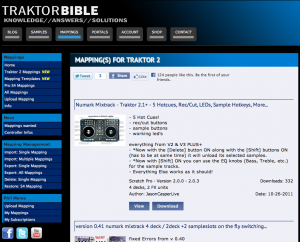The Lowdown
The book is great if you want a decent printed manual for Traktor, and of course it’s much more than that. If you’d benefit from measured discussion of everything from file handling and metadata to key mixing theory and beatmatching – discussion that isn’t dumbed down but still remains concise and clear – you’ll find it here.
Video Review
In Use
Traktor is a powerful and versatile program, but it’s also a complex one. Just getting it set up to work properly can be a challenge, and later on – when you’ve used it many times – you face the additional challenge of harnessing some of that versatility once you feel the need to customise the program to your own ends.
At either of these times, you may wish for additional help over and above scouring forums or battling with Traktor’s online help, and that’s where Rainer G. Haselier’s book Traktor 2 Bible comes in.
This rather large, 364-page paperback (available in German and English – I’m reviewing the English edition here) is partly a “missing manual”, partly a guide to the more technical aspects of digital DJing, and partly a music theory book. So whether you’re struggling with basic configuration issues, grappling with digital file organisation and Midi, or stuck on sync, bars and key mixing, Rainer has you covered.
The book has been around for a couple of years now, but has recently been updated for the Traktor 2 range. Of course, it’s the nature of software guides that they are out of date practically as soon as they’re printed, so there’s a membership scheme called Traktor Bible Plus which you can join for free on the book’s sister website where chapter by chapter, additions are made available. There are also ready-made mappings there, which is a great resource.

I found the sections on library management / iTunes integration and what Traktor actually does to your MP3s to be invaluable reading, but there’s also particularly a lot of information here that people working on custom mappings will find to be solid gold for their needs.
Indeed the book is completely comprehensive, so whatever you’re struggling with in the program, it is definitely covered here. It’s bang up to date with regards things like the sample decks, and the loop recorder, for instance, and it also has a comprehensive section on Traktor’s multitude of effects.
But there’s material here that moves beyond the realms of Traktor, too, with a beatgridding tutorial using real tracks that you can download, which could be useful for beatgridding in any software (although of course it uses Traktor), and even a section on using the open-source digital audio workstation Audacity to divide your Traktor-recorded mixtapes into individual tracks for successful burning to CD.
Conclusion
Traktor 2 Bible is an advanced book, and it’s rather dry in places, but arguably it’s just reflecting the software that it addresses in these matters. It’s hard to make Midi protocol and mapping sexy, after all!
The book is great if you want a decent printed manual for Traktor, but as we’ve seen it’s more than that. If you’d benefit from measured discussion of everything from file handling and metadata to key mixing theory and beatmatching – discussion that isn’t dumbed down but still remains concise and clear – you’ll find it here. I don’t usually add review books to my library, but this one has a wide enough scope that I know there’s stuff in it I’ll want to refer back to for probably several years to come. I’m glad to be holding on to it.
I’m popping it up there right next to “Last Night A DJ Saved My Life” and “The DJ’s Handbook: From Scratch to Stardom”. (The former I thoroughly recommend, the latter I certainly don’t – but more about that on another day…)




